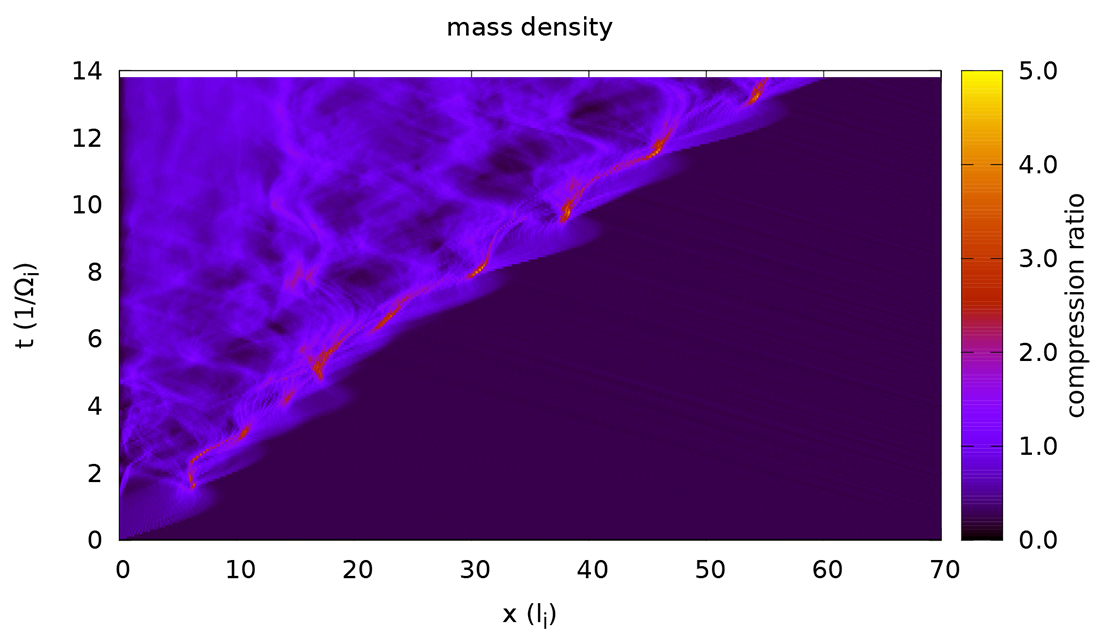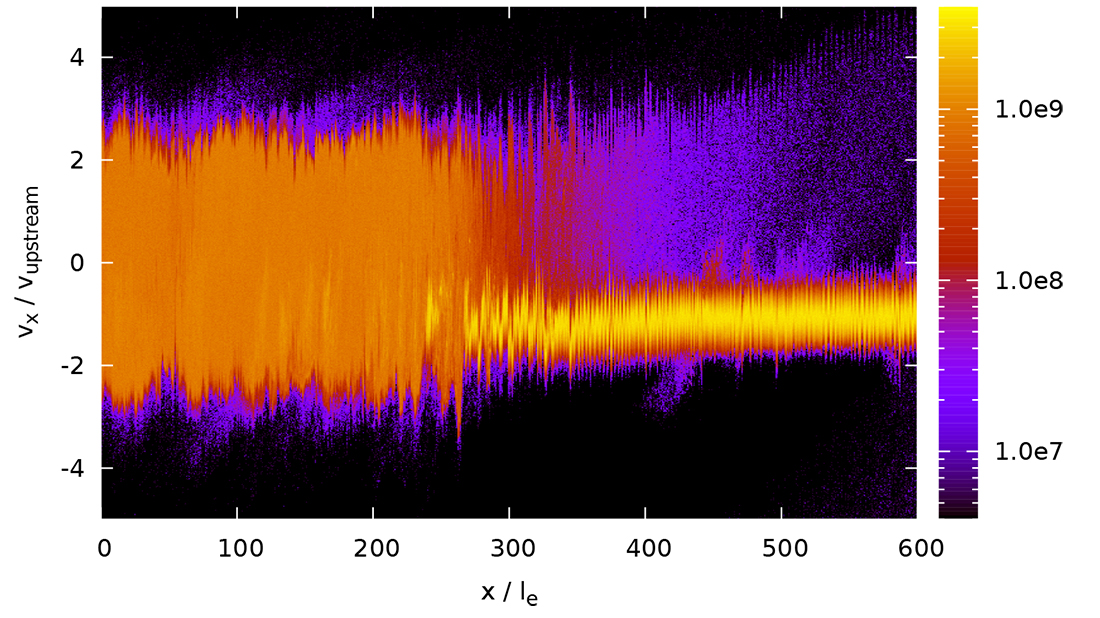ASTROPHYSICS
Electron Acceleration in Non-Relativistic Shocks (EAINRS)
Principal Investigator:
Patrick Kilian
Affiliation:
Lehrstuhl für Astronomie, Universität Würzburg (Germany)
Local Project ID:
EAINRS
HPC Platform used:
Hermit of HLRS
Date published:
Observations show that Earth is constantly bombarded by highly energetic particles that are called cosmic rays. A possible explanation for the origin of the cosmic rays as well as their energy distribution is particle acceleration at shock fronts. Several different physical processes take place there, but due to the large astrophysical distances it is, unfortunately, impossible to study these in-situ. One way out is large scale computer simulations.
To test and improve existing computer models it is important to validate them against cases where analytic solutions or observational data are available. One case where at least some in-situ measurements exists are shocks in the solar wind. These happen much closer to Earth and can be observed using satellites. These shocks in the solar wind are typically driven by coronal mass ejections (CMEs). These can propagate at high velocities which causes a shock front in front of the ejected material and which is associated with solar energetic particles.
The comparison is complicated by two problems: Satellites yield only local information from their position and follow a fixed orbit, which may only by chance cross a shock front. It is very hard to disentangle the resulting measured data into effects that come from the temporal evolution of the shock front and the differences between different locations across the shock.
The second problem is related to the simulation technique. While the shocks that generate the relativistic cosmic rays are relativistic themselves, CMEs driven shocks propagate much slower – at about 1,000 km/s. This is still a tremendous velocity, but much slower than the speed of light. (This is also the reason for the project name: Electron Acceleration at Non-Relativistic Shocks). The numerical scheme, however, has to proceed in very small time steps to allow for the propagation of radio waves that are also related with those shock fronts and which can be observed as radio bursts. A simulation, therefore, has to proceed in millions of tiny increments. The only way to get results that describe the particle motion at much longer timescales therefore is to use a computer that is fast enough to compute each time step very quickly. Each simulation step requires the handling of millions of particles, thus the need for a supercomputer, in this case the HPC system Hermit of HLRS in Stuttgart.
Improvements in the simulation code that were made during the project and increased confidence in its correctness allow to use it for research into the origin of the cosmic rays, one fundamental question in astrophysics.
One the other hand the simulation of CME driven shocks improved, which someday could lead to predictions of the particle flow that can be expect from a given CME. This information would be useful for operators whose satellites might be adversely affected by the energetic particles produced by the shock.

Fig. 01: A plot of the compression ratio (the ratio between the mass density and the initial density) as a function of space (on the right axis) and time (on the up axis). One can see the shock front moving to the right as time passes and the formation of a dense downstream region to the left of the shock front. Also visible is the fact that the shock front is not static but exhibits a quasi-periodic behavior where is cycles through faster propagation and larger compression.
Copyright: Lehrstuhl für Astronomie, Universität Würzburg
Fig. 02: A plot that shows in color code how often electrons of different velocities (up axis) occur at different locations (right axis). It is clearly visible that particles flow towards the shock from the right with a velocity of -1. The temperature that can be seen from the spread in velocities the small. Left of the shock the average speed is 0, but the thermal spread is huge (-2 to 2). The shock has slowed down the upstream population and converted a lot of the kinetic energy into heat. But some particles escape the shock and travel to the right at velocities much larger than the incoming velocity. (Top right, velocities > 4). The plot is in a reference system where the downstream is at rest and all velocities are expressed as multiples of the upstream velocity in this frame.
Copyright: LehrsturonhUnivel für Astomie, rsität WürzburgScientific Contact:
Patrick Kilian
Universität Würzburg, Lehrstuhl für Astronomie
Campus Hubland Nord
Emil-Fischer-Straße 31, D-97074 Würzburg/Germany
e-mail: pkilian [at] astro.uni-wuerzburg.de